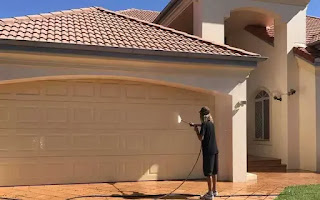The Power of Pressure Washing: A Deep Dive
Pressure washing, also known as power washing, is a versatile and effective cleaning method that can transform grimy surfaces into sparkling clean ones. In this blog, we'll explore the ins and outs of pressure washing, its benefits, best practices, and the various surfaces it can rejuvenate. Let's dive in.
What is Pressure Washing?
Pressure washing is a cleaning technique that uses high-pressure water to remove dirt, grime, mold, mildew, and other contaminants from a wide range of surfaces. The equipment typically consists of a high-powered pump, a hose, and a nozzle. Water is pressurized and then expelled through the nozzle at a force strong enough to dislodge dirt and stains.
The Benefits of Pressure Washing
Pressure washing offers several advantages, making it a popular choice for homeowners and businesses alike:
1. Enhanced Curb Appeal: A clean exterior dramatically improves the appearance of your home or business, leaving a lasting impression on visitors and potential customers.
2. Preventive Maintenance: Regular pressure washing helps prevent the build-up of mold, mildew, and dirt, reducing the risk of long-term damage to your property.
3. Cost-Effective: Pressure washing is often more affordable than replacing or repainting surfaces. It can extend the lifespan of your property's exterior.
4. Eco-Friendly: Pressure washing typically requires fewer chemicals compared to other cleaning methods, making it an environmentally responsible choice.
When to Use Pressure Washing
Pressure washing is a versatile cleaning method suitable for a variety of surfaces and applications:
1. Home Exteriors:
Pressure washing is excellent for removing dirt, mold, mildew, and grime from siding, brick, stucco, and painted surfaces. It can restore your home's beauty.
2. Decks and Patios:
Wooden decks and concrete patios can accumulate dirt and stains over time. Pressure washing quickly revitalizes these outdoor spaces.
3. Driveways and Walkways:
Concrete driveways and pathways are exposed to heavy foot and vehicle traffic. Pressure washing keeps them looking clean and well-maintained.
4. Fences:
Wooden and vinyl fences can develop mold and discoloration. Pressure washing restores their appearance and durability.
Best Practices for Pressure Washing
To achieve the best results and prevent damage, consider these best practices:
1. Safety First: Always wear appropriate safety gear, including goggles and hearing protection, and follow manufacturer guidelines for the pressure washer.
2. Choose the Right Nozzle: Different nozzles produce various spray patterns. Select the appropriate one for the task at hand.
3. Maintain the Right Distance: Keep the nozzle at a safe distance from the surface to prevent damage. The distance may vary depending on the material.
4. Use the Right Pressure: Adjust the pressure to the surface you're cleaning. High-pressure settings can damage delicate surfaces, while low pressure may not remove tough stains.
5. Test in an Inconspicuous Area: Before you start, test the pressure washer in an inconspicuous spot to ensure it won't harm the surface.
In conclusion, pressure washing is a powerful and versatile method for cleaning a wide range of surfaces. It offers numerous benefits, including improved aesthetics, preventive maintenance, cost-effectiveness, and eco-friendliness. When used correctly and with care, pressure washing can be a game-changer for maintaining and enhancing your property's appearance.
So, whether it's your home's siding, deck, driveway, or even your vehicle, don't hesitate to harness the power of pressure washing to keep everything looking clean and refreshed.



Comments
Post a Comment